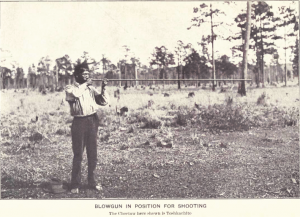The primitive blowgun was used until recently in hunting squirrels, rabbits, and various birds. Only one specimen was found at Bayou Lacomb; this was said to have been made some ten years ago. The man Toshkachîto (Joe Silestine) is shown holding the blowgun in position for shooting in the image below. The blowgun (kaklu’mpa) is about 7 feet in length; it is made of a single piece of cane (Arundinaria macrosperma; Choctaw, uske),formed into a tube by perforation of the joints, which was given a smooth bore of uniform diameter throughout. The darts (shurma’nte) are made of either small, slender canes or pieces of hard yellow pine, sharpened at one end; they are from 15 to 18 inches in length. The lower end is wrapped for a distance of 4 or 5 inches with a narrow band of cloth having a frayed edge, or a piece of soft tanned skin is used. The effect of this band is to expand and fill the bore of the gun, a result that could not possibly be secured by the use of feathers, as in the case of ordinary arrows.

Bows and arrows were formerly used, but for many generations the Choctaw have been in possession of firearms obtained from the French, the Spanish, and later from the Americans.
Curiously enough the people at Bayou Lacomb do not care for fish or fishing, although quantities of excellent fish could be taken from the bayous and from Lake Pontchartrain. The Choctaw say they formerly had fish traps in the bayous, but seem not to remember how they were constructed.
